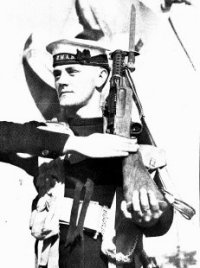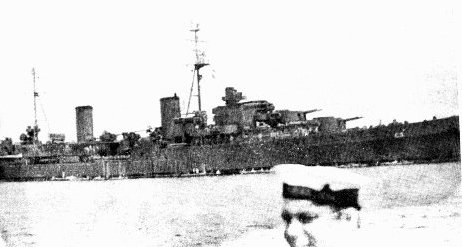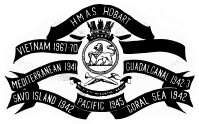
" SHE " - HMAS
by Graham Donaldson
|
"Story of a Lucky Ship" P.R.Buring RAN, `As You Were 1947'- page 82-84 published by the AWM Canberra "in memory of fallen comrades" Across the Seven Seas
He joined her in early May 1941, she had been on station south of the Suez, since, she spent Christmas `40 at Bab-el Mandeb, the Red Sea, patrolling and escorting back and forth in the Gulf of Aden and the Arabian Sea. He heard the story of her acting as a lone carrier and the time her amphibious scout plane made a solo tactical bombing raid on the Italian airfield at Zeila, Somaliland. The outrage at this audacity prompted Mussolini's bombers to retaliate, returning the compliment, by straddling her with bombs. How for the evacuation of Berbera a score of HM ships, including the hospital vessel `Vita and the transport `Akbar, plus two tugs `Zeila & `Queen and four barges manned by Royal Australian Navy personnel came under her direction. How as a troop landing ship she disembarked 681 troops, and officers, of a Punjabi battalion for rearguard actions and throughout the operation fascist Italian listening wireless propaganda chatted about Dunkirk and glorious retreats but she, true to traditionally carried on. Then soon after dawn she launched her Seagull amphibian on a reconnaissance of the approaches to the port over the Berbera Plains, no enemy activity was observed and the whole operation was a successfully completed, except for three foot-slogging stragglers from the King's African Rifles, she picked them up on the beach. He was told the tale that at Aden she embarked eight midshipmen for transfer by bosun's chair onto the battleship `Ramillies. On this occasion she gave hands on service to royalty, as one of the joiner officers was Prince Philip of Greece, later through marriage to become HRH Duke of Edinburgh. Now with current orders she steamed across the Indian Ocean to eventually relieve her sister-ship `Perth in the Eastern Mediterranean. The continuing voyage was uneventful until her arrival at Suez, the fringe of the war-zone, within Italian & German long-range bomber hunting grounds and she had experienced aerial bombing attacks having her fair share of attention back in October `40. She was scheduled to pass through but due to recent enemy aircraft activity the Canal was temporarily closed during minesweeping operations. The captain was in two minds to anchor, where she was, or to re-enter the Bay of Tewfik and anchor off the entrance to the canal, he chose the later. That night enemy bombers systematically bombed the former area at which it had been proposed to anchor her, opposite the French Club. Then a stick of bombs completely gutted the `Georgic, a little over three hundred yards away. The following day on arrival at Bitter Lakes she temporarily anchored before proceeding to Ismaila and not more than twenty minutes after leaving many bombs were dropped around that previous anchorage amidst the other warships and targets. That night passing through Ismaila enemy planes were heard overhead and sighted in the searchlight beams, yet no attack was made. On arrival at Alexandria she was allotted a berth next to the Hospital-ship `Maine, experienced another air raid and left for Haifa. On arrival there, the ships crew learnt that the port had been raided consistently for weeks. And from the day of her arrival till the day of her departure, fourteen days, there was not one air raid alarm, but ten hours after leaving the port it was heavily raided. On return to Alexandria her original posted berth had been temporarily occupied and she proceeded to Kamaria breakwater. When the enemy aircraft raided the Harbour that night, three thousand pounder bombs straddled her rightful berth and badly blasted and killed several seamen on the visiting newcomer. A week later she left Port Said to ferry troops to Cyprus. With one night in Port Said, no air raid came and that was after weeks & weeks of nightly incursions. Next morning after venturing from Famagusta, Cyprus, she was arriving as the last of the raiders left after an all night attack then twenty minutes after leaving Famagusta there shrilled an alarm, the start of another heavy raid. A few days later she put to sea with the Battle Fleet, it was the first occasion that the armada had put to sea without being subjected to an air attack. Upon returning to port she was assaulted by three Italian torpedo-bombers, unsuccessfully as no hits were scored. Three weeks later at midnight off Bardia, Libya, she was hurling six-inch "projjies" into the Italian shore installations, then a few miles astern the Latona was torpedoed and sunk. To Greece and Crete where she was overlooked by the Stukas and other enemy dive-bombers in favour of more lucrative targets, His Majesty's Ships Coventry, Ajax, Neptune, Flamingo, Barham, Somerset, Jackal and Glenroy all bombed, damaged or sunk. Four trips along the Libyan coast she remained undetected or ignored, by marauding enemy aircraft while bombarding key enemy defences and lines of communication. 
The lucky ship Then the Japanese came into the fray and she, of course, had to be in on that fight. She was hurried through the Suez Canal, swiftly down the Red Sea, sped across the Arabian Sea, picked up a convoy at Colombo and set a course for Singapore, which was being assailed day and night. She went carefully through the enemy dominated waters, keeping her eyes on the distant sky, straight in near a warehouse containing five hundred torpedoes and there was only one spasmodic air raid ! She lay alongside the PowerHouse and when the bombers came over it was the hottest spot in the Harbour. As her bell rang 8 o'clock the ship's guard sprang smartly to attention and presented arms, with the first bars of the National Anthem sounding out the air raid sirens joined the tune, wailing their warning of an imminent attack. Anyway, regardless the ceremony was completed as overhead passed a flight of fifty-four Japanese aircraft ignoring her for a prior engagement elsewhere. Leaving the fiercely burning Singapore to its stricken fate she returned to Fremantle, Australia, for a quick lull back home and gathered up another convoy to be escorted towards Banka Strait. Here she was attacked by five inaccurate Japanese heavy level bombers, not even a near miss could burst her curvaceous shapely line. Later, secure at Keppel Harbour for two days and during the bomber raids against the docks, incendiaries were dropped that started many raging fires and bombs crashed down on the quayside, yet none hit her. The next day she was skirting an unknown minefield, when her escort destroyer frantically signalled the danger then proceeding down "Bomb Alley" and she was subjected to more aerial attacks, all missed and she finally arrived at Batavia. A week later, with `Exeter to intercept a superior force of surface ships off Banka Island, she had three courtiers in the shape of Japanese bombers buzzing around trying to discourage the pair of vessels from venturing further and a few casualties were caused through persistent petting. In company of a fairly substantial force, two days later, she again attempted to force the Banka & Rhio Straits. From noon the Japanese aircraft kept coming till sunset and few of her ships company, at the time, will never forget the flock of one hundred and thirteen red dotted Japanese warplanes. "Action Stations", she gave them all she had pumping Oerlikon into the sky. During the whole ordeal hundreds of bombs were dropped, she twisted and turned, none scored a hit and the return shooting skittled a couple of enemy bombers. Back to Batavia to refuel from the tanker, War Sidar berthed along side the docks. Upon commencement of fuelling a heavy raid began and a stick of forty odd bombs fell in a dead straight line a few yards to starboard. The whitewash cascaded forth with the crash boom of high explosive but apart from superficial damage there were only a few minor accidents from the after shock and dynamic water displacement. An aerial bomb however had hit the tanker through the fo'c'sle-head and salt water contaminated the oil storage tanks as the ship began to list. Through the lack of fuel she was unable to put to sea and join the naval force going to attempt to stem the Japanese advance on Java. The fate of that combined fleet of Australian, British, Dutch and American vessels in the final fight of Java Sea is now history, not one allied ship survived. She made for Sunda Strait bottleneck with two old English spinster chaperones `Dragon and `Danae. An enemy "recco" sighted the surface ships and falsely classed them as a battleship and two cruisers. And as a result the superior Japanese force steaming to intercept and engage her, and her cohorts, withdrew northward under the protection of their air cover. Making her run through Sunda the following evening the three cruising sister ships were mistaken for a enemy task force by the patrol pilots and allowed to proceed unmolested, the sole survivors of the Far Eastern Fleet. Skirting the enemy held coast of Sumatra she evaded searching squadrons of enemy aircraft and won out to the free open waters of the Indian Ocean. A month or so later, after a rest and refit for her and the gallant crew, she went to the Coral Sea. There three torpedoes were launched from attacking enemy planes at such an attractive target, going for her like lances, piercing down either side, the warhead armed "fish" passed on by and disappeared astern. The enemy planes were scattered and broken making off over the horizon. She moved onto the Battle of the Solomons taking part in the entire operation, guarding the troopships and drab transports with precious cargoes from surface and underwater attack. On one occasion she survived an assault by forty determined airborne attackers. A message had been communicated to her main wireless office, "to any US man o'war - Urgent - from J.E.R. (a Coastwatcher) x-forty planes passing Bougainville heading Tulagi area - 0945." What little time left till the attack dragged on but she was ready to repel the enemy aircraft, when a burst of ack-ack fire from a distant picket drew everyone's attention. Dozens of torpedo bombers flying very low, very fast, spewing long bursts of machine-gun tracers, they presented a disturbing sight. She opened up with every weapon available and capable of discharging projectiles, from 6inch to .303 Lewis, the clatter of her armaments was terrific. There were only two casualties, one of the after-starboard Oerlikon gunner had his overalls blown off by the blast of `Y turret and the other bloke, on the upper deck party, dropped a box of ammunition on his arm, breaking it ! During the long nights it was her job to guard the lower approach to Tulagi. One Sunday night the Imperial Japanese Navy attempted to sneak in through the north passage and she, only a few miles away, seeing the sight of the gun flashes & searchlight beam battle, steamed on station unscathed. It was in June `43 that she collected a "fish", it struck her aft, the damage was horrific but the sad loss of life was amazingly small considering the explosive content of the torpedo's warhead. She made it to Sydney under her own power, perhaps after the patch job her luck would run thin. Not likely, she had an excursion into the Philippines with her sister-ships and witnessed the devastating Kamikaze attacks. In the Borneo operations of `45 she bombarded Klandasan, Balikpapan in preparation for the biggest Australian amphibious assault launched during the war. On the northern New Guinea coast off Wewak Peninsula she gave support to land manoeuvres by the sea. She even had the prestigious position of the Flagship of His Majesty's Australian Squadron, Japan, during the allied occupation. Well its light out, yet whenever you hear talk about lucky ships, remember one of the luckiest of them all was HMAS Hobart. 
Source
|